
Epacris impressa, also known as common heath, is a plant of the heath family, Ericaceae, that is native to southeast Australia. French botanist Jacques Labillardière collected the species in 1793 and described it in 1805. Four forms have been identified, but no subspecies are recognised. Growing in heathland, shrubland or open forest, it is generally a small shrub around 0.5 to 1 m tall, with small stiff leaves. The red, pink or white tube-like flowers appear from late autumn to early spring. Honeyeater birds, particularly the eastern spinebill, feed upon the nectar of the flowers. It regenerates after bushfire by seed or by resprouting.

Telopea speciosissima, commonly known as the New South Wales waratah or simply waratah, is a large shrub in the plant family Proteaceae. It is endemic to New South Wales in Australia and is the floral emblem of that state. No subspecies are recognised, but the closely related Telopea aspera was only recently classified as a separate species.
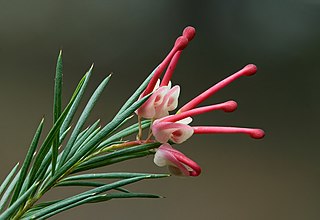
Grevillea rosmarinifolia, the rosemary grevillea, is a plant of the family Proteaceae.

Xerochrysum bracteatum, commonly known as the golden everlasting or strawflower, is a flowering plant in the family Asteraceae native to Australia. Described by Étienne Pierre Ventenat in 1803, it was known as Helichrysum bracteatum for many years before being transferred to a new genus Xerochrysum in 1990. It is an annual up to 1 m (3.3 ft) tall with green or grey leafy foliage. Golden yellow or white flower heads are produced from spring to autumn; their distinctive feature is the papery bracts that resemble petals. The species is widespread, growing in a variety of habitats across the country, from rainforest margins to deserts and subalpine areas. The golden everlasting serves as food for various larvae of lepidopterans, and adult butterflies, hoverflies, native bees, small beetles, and grasshoppers visit the flower heads.

Banksia paludosa, commonly known as the marsh or swamp banksia, is a species of shrub in the plant genus Banksia. It is native to New South Wales, Australia, where it is found between Sydney and Batemans Bay, with an isolated population further south around Eden. There are two recognised subspecies, the nominate of which is a spreading shrub to 1.5 m (4.9 ft) in height, and subsp. astrolux is a taller shrub to 5 m (16 ft) high found only in Nattai National Park.

Pultenaea is a genus of about 100 species of flowering plants in the family Fabaceae, and is endemic to Australia. Plants in this genus are shrubs with simple leaves and orange or yellow flowers similar to others in the family but with the standard petal equal to or slightly longer than the other petals.

Hydrangea arborescens, commonly known as smooth hydrangea, wild hydrangea, sevenbark, or in some cases, sheep flower, is a species of flowering plant in the family Hydrangeaceae. It is a small- to medium-sized, deciduous shrub up to 3 m (10 ft) tall that is native to the eastern United States.

Prostanthera lasianthos, commonly known as the Victorian Christmas bush or coranderrk , is a large shrub or small tree of the mint family, Lamiaceae, which is native to Queensland, New South Wales, Victoria and Tasmania in Australia. It grows up to 10 m (35 ft) high but is usually much less and is found in wet sclerophyll forests, often beside creeks. Its flowers, which appear in profuse sprays, are about 2 cm long and white or pale lilac, with purple and orange blotches in the throat. They appear in late spring and summer, and specifically around Christmas time in Victoria. The fragrant, toothed leaves are 4 to 12 cm long and about 1.5 cm wide.
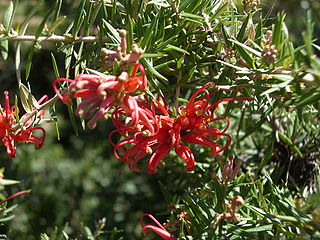
Grevillea juniperina, commonly known as juniper- or juniper-leaf grevillea or prickly spider-flower, is a plant of the family Proteaceae native to eastern New South Wales and southeastern Queensland in Australia. Scottish botanist Robert Brown described the species in 1810, and seven subspecies are recognised. One subspecies, G. j. juniperina, is restricted to Western Sydney and environs and is threatened by loss of habitat and housing development.

Leucophyta is a plant genus which is endemic to Australia. The genus was first formally described by botanist Robert Brown in 1818.
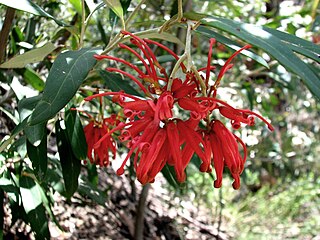
Grevillea victoriae, also known as royal grevillea or mountain grevillea, is a shrub which is endemic to south-eastern New South Wales and mountainous parts of Victoria in Australia.
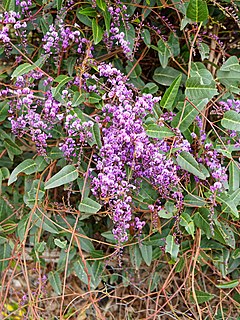
Hardenbergia violacea is a species of flowering plant in the family Fabaceae and is endemic to Australia. It is known in Australia by the common names false sarsaparilla, purple coral pea and waraburra. Elsewhere it is also called purple twining-pea, vine-lilac and wild sarsaparilla. It is a prostrate or climbing subshrub with egg-shaped to narrow lance-shaped leaves and racemes of mostly purple flowers.

Alyxia buxifolia, otherwise known as the sea box or dysentery bush, is a species of evergreen shrub in the family Apocynaceae.

Olearia phlogopappa commonly known as the dusty daisy-bush or alpine daisy-bush is a species of flowering plant in the family Asteraceae that is commonly found in eastern New South Wales, Victoria and Tasmania. It is a small shrub with greyish-green foliage, daisy-like flowers in white, pink or mauve that can be seen from spring to late summer.

Telopea oreades, commonly known as the Gippsland-, mountain- or Victorian waratah, is a large shrub or small tree in the family Proteaceae. Native to southeastern Australia, it is found in wet sclerophyll forest and rainforest on rich acidic soils high in organic matter. No subspecies are recognised, though a northern isolated population hybridises extensively with the Braidwood waratah (T. mongaensis). Reaching a height of up to 19 metres, T. oreades grows with a single trunk and erect habit. It has dark green leaves with prominent veins that are 11–28 centimetres (4.3–11 in) long and 1.5–6 cm (0.6–2.4 in) wide. The red flower heads, known as inflorescences, appear in late spring. Each is composed of up to 60 individual flowers.
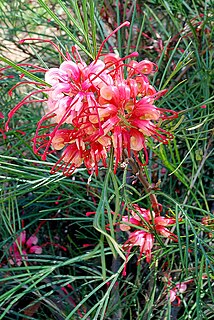
Grevillea johnsonii, commonly known as Johnson's grevillea or Johnson's spider flower, is a species of flowering plant in the family Proteaceae and is endemic to New South Wales. It is a shrub with divided, needle-like leaves and red to orange flowers, and grows in rocky places.
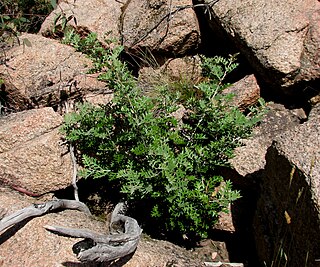
Grevillea willisii is a shrub species which is endemic to the eastern highlands of Victoria, in Australia. Common names include Omeo grevillea and rock grevillea.
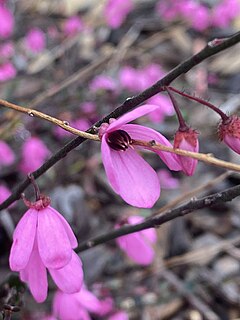
Tetratheca ciliata, commonly known as pink bells, is a small shrub in the family Elaeocarpaceae. It is endemic to southern Australia.

Melaleuca thymifolia, commonly known as thyme honey-myrtle, is a plant in the myrtle family Myrtaceae and is native to eastern Australia. It is often noticed in spring, with its attractive, purple flowers and is one of the most commonly cultivated melaleucas. A fragrant shrub, it usually grows to about 1.0 m (3 ft) tall, has corky bark and slender, wiry stems.
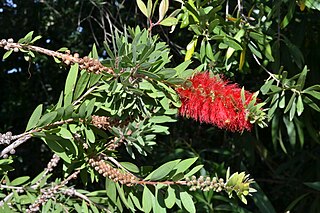
Melaleuca citrina, the common red bottlebrush, crimson bottlebrush, or lemon bottlebrush, is a plant in the myrtle family Myrtaceae, and is endemic to eastern Australia. Some Australian state herbaria continue to use the name Callistemon citrinus. It is a hardy and adaptable species, common in its natural habitat. It is widely cultivated, not only in Australia. It was one of the first Australian plants to be grown outside the country, having been taken to England in 1770 by Joseph Banks. Its showy red flower spikes, present over most of the year in an ideal situation, account for its popularity.





















